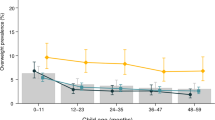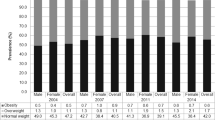Abstract
Objective:
To examine trends in under- and overweight prevalence from 1991 to 2004 among adults and children in China by income and residence differentials.
Methods/Subjects:
Prevalence, average annual changes and annual relative changes in under- and overweight were determined. In 1991, 2848 children and 6806 adults were surveyed. The 2004 survey included 1566 children and 6172 adults.
Results:
Higher average annual reductions in underweight prevalence were found among children, particularly rural children, when compared with adults. With respect to income, low-income children and adults experienced the greatest average annual reductions in underweight prevalence. The trend for increased overweight was more pronounced than the trend for decreased underweight. Intensified trends were found among adults (versus children) and males (versus females). Relative to baseline prevalence, overweight increased fastest among adults in low-income and rural populations.
Conclusions:
Rapid increases in the overweight prevalence, particularly as found among low-income and rural Chinese adults, will likely lead to a shift in the burden of obesity-related chronic diseases toward the poor. Associated economic and health implications will further challenge the country's health care system, restrain economic development and widen existing disparities between the rural and urban as well as between the rich and poor populations of China.
This is a preview of subscription content, access via your institution
Access options
Subscribe to this journal
Receive 12 print issues and online access
$259.00 per year
only $21.58 per issue
Buy this article
- Purchase on Springer Link
- Instant access to full article PDF
Prices may be subject to local taxes which are calculated during checkout


Similar content being viewed by others
References
Bell AC, Ge K, Popkin BM (2001). Weight gain and its predictors in Chinese adults. Int J Obes Relat Metab Disord 25, 1079–1086.
Bell AC, Ge K, Popkin BM (2002). The road to obesity or the path to prevention: motorized transportation and obesity in China. Obes Res 10, 277–283.
Blumenthal D, Hsiao W (2005). Privatization and its discontents – the evolving Chinese health care system. N Engl J Med 353, 1165–1170.
Chang Y, Zhai F, Li W, Ge K, Jin D, de Onis M (1994). Nutritional status of preschool children in poor rural areas of China. Bull World Health Organ 72, 105–112.
Doak CM, Adair LS, Bentley M, Monteiro C, Popkin BM (2005). The dual burden household and the nutrition transition paradox. Int J Obes Relat Metab Disord 29, 129–136.
Du S, Mroz TA, Zhai F, Popkin BM (2004). Rapid income growth adversely affects diet quality in China – particularly for the poor!. Soc Sci Med 59, 1505–1515.
Fung MS, Yuen M (2003). Body image and eating attitudes among adolescent Chinese girls in Hong Kong. Percep Mot Skills 96, 57–66.
Ge K, Fu DW (2001). The magnitude and trends of under- and over-nutrition in Asian countries. Biomed Environ Sci 14, 53–60.
Ge K, Weisell R, Guo X, Cheng L, Ma H, Zhai F et al. (1994). The body mass index of Chinese adults in the 1980s. Eur J Clin Nutr 48 (Suppl 3), S148–S154.
Ge K, Zhai F, Yan H (1996). The dietary and nutritional status of Chinese population: 1992 National Nutrition Survey. People's Medical Publishing House: Beijing.
Griffiths PL, Bentley ME (2001). The nutrition transition is underway in India. J Nutr 131, 2692–2700.
Gu D, Reynolds K, Wu X, Chen J, Duan X, Reynolds RF et al. (2005). Prevalence of the metabolic syndrome and overweight among adults in China. Lancet 365, 1398–1405.
Haslam DW, James WP (2005). Obesity. Lancet 366, 1197–1209.
Ji CY, Sun JL, Chen TJ (2004). Dynamic analysis on the prevalence of obesity and overweight of school-age children and adolescents in recent 15 years in China [Article in Chinese]. Chinese J Epidemiol 25, 103–108.
Lee S (1993). How abnormal is the desire for slimness? A survey of eating attitudes and behaviour among Chinese undergraduates in Hong Kong. Psychol Med 23, 437–451.
Lee S, Lee AM (2000). Disordered eating in three communities of China: a comparative study of female high school students in Hong Kong, Shenzhen, and rural Hunan. Int J Eat Disord 27, 317–327.
Lee S, Leung T, Lee AM, Yu H, Leung CM (1996). Body dissatisfaction among Chinese undergraduates and its implications for eating disorders in Hong Kong. Int J Eat Disord 20, 77–84.
Li Y, Guo G, Shi A, Li Y, Anme T, Ushijima H (1999). Prevalence and correlates of malnutrition among children in rural minority areas of China. Pediatr Int 41, 549–556.
Luo W, Zhai F, Jin S, Ge K (2001). Intrahousehold food distribution: a case study of eight provinces in China. Asia Pac J Clin Nutr 10 (Suppl), S19–S28.
Mendez MA, Monteiro CA, Popkin BM (2005). Overweight exceeds underweight among women in most developing countries. Am J Clin Nutr 81, 714–721.
Monteiro CA, Conde WL, Popkin BM (2002). Is obesity replacing or adding to undernutrition? Evidence from different social classes in Brazil. Public Health Nutr 5, 105–112.
Monteiro CA, Conde WL, Popkin BM (2004). The burden of disease from undernutrition and overnutrition in countries undergoing rapid nutrition transition: a view from Brazil. Am J Public Health 94, 433–434.
Paeratakul S, Popkin BM, Ge K, Adair LS, Stevens J (1998). Changes in diet and physical activity affect the body mass index of Chinese adults. Int J Obes Relat Metab Disord 22, 424–431.
Popkin BM (2006). Global nutrition dynamics: the world is shifting rapidly toward a diet linked with noncommunicable diseases. Am J Clin Nutr 84, 289–298.
Popkin BM, Conde W, Hou N, Monteiro C (2006). Is there a lag globally in overweight trends for children as compared to adults? Obesity 14, 1846–1853.
Popkin BM, Du S (2003). Dynamics of the nutrition transition toward the animal foods sector in China and its implications: a worried perspective. J Nutr 133 (11 Suppl 2), 3898S–3906S.
Popkin BM, Kim S, Rusev ER, Du S, Zizza C (2006). Measuring the full economic costs of diet, physical activity and obesity-related chronic diseases. Obes Rev 7, 271–293.
Popkin BM, Paeratakul S, Ge K, Zhai F (1995). Body weight patterns among the Chinese: results from the 1989 and 1991 China Health and Nutrition Surveys. Am J Public Health 85, 690–694.
Popkin BM, Paeratakul S, Zhai F, Ge K (1995). A review of dietary and environmental correlates of obesity with emphasis on developing countries. Obesity Research 3 (Suppl 2), 145S–153S.
State Statistical Bureau (2004). China Statistical Yearbook 2004. China Statistical Press: Beijing.
United Nations Development Program (2005). China Development Research Foundation: China Human Development Report 2005 pp. 21–37.
Wang H, Du S, Zhai F, Popkin BM (2006a). Trends in the distribution of body mass index among Chinese adults, aged 20–45 years (1989–2000). Int J Obes 31, 272–278.
Wang Y, Ge K, Popkin BM (2003). Why do some overweight children remain overweight, whereas others do not? Public Health Nutr 6, 549–558.
Wang Y, Mi J, Shan XY, Wang QJ, Ge KY (2006b). Is China facing an obesity epidemic and the consequences? The trends in obesity and chronic disease in China. Int J Obes 31, 177–188.
Wang Y, Monteiro C, Popkin BM (2002). Trends of obesity and underweight in older children and adolescents in the United States, Brazil, China, and Russia. Am J Clin Nutr 75, 971–977.
Wang Y, Popkin B, Zhai F (1998). The nutritional status and dietary pattern of Chinese adolescents, 1991 and 1993. Eur J Clin Nutr 52, 908–916.
Wang Z, Zhai F, He Y, Hu Y (2007). Trends and prevalence of malnutrition among children under five year-old in Chinese rural of different classes. Wei Sheng Yan Jiu 36, 82–85.
World Bank (2005). China's Health Sector—Why reform is needed, Rural Health in China: Briefing Note no. 3 Rural Health in China: Briefing Notes Series, Washington, DC.
Acknowledgements
We thank the NIH (R01-HD30880 and R01-HD38700) for financial support for the analysis. We also thank Ms Frances L Dancy for administrative assistance, Mr Tom Swasey for graphics support and Du Shufa for research help. None of the authors has conflict of interests of any type with respect to this manuscript.
Support for the study was provided by NIH grant nos. R01-HD30880 and R01-HD38700.
Author information
Authors and Affiliations
Corresponding author
Rights and permissions
About this article
Cite this article
Dearth-Wesley, T., Wang, H. & Popkin, B. Under- and overnutrition dynamics in Chinese children and adults (1991–2004). Eur J Clin Nutr 62, 1302–1307 (2008). https://doi.org/10.1038/sj.ejcn.1602853
Received:
Revised:
Accepted:
Published:
Issue Date:
DOI: https://doi.org/10.1038/sj.ejcn.1602853
Keywords
This article is cited by
-
Compared with dietary behavior and physical activity risk, sedentary behavior risk is an important factor in overweight and obesity: evidence from a study of children and adolescents aged 13–18 years in Xinjiang, China
BMC Pediatrics (2022)
-
The triple benefits of slimming and greening the Chinese food system
Nature Food (2022)
-
National trends in stunting, thinness and overweight among Chinese school-aged children, 1985–2014
International Journal of Obesity (2019)
-
Perceived Discrimination, Screen Use, and BMI Among Rural-to-Urban Migrant Children in China: Evidence from a Nutrition Transition Context
Journal of Immigrant and Minority Health (2019)
-
Sugary beverage consumption mediates the relationship between late chronotype, sleep duration, and weight increase among undergraduates: a cross-sectional study
Environmental Health and Preventive Medicine (2018)



